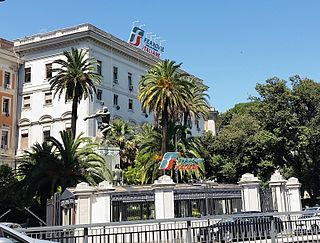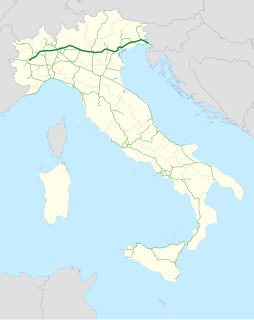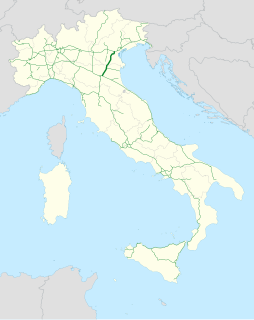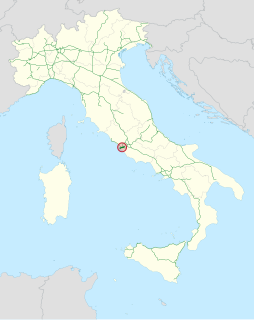
The Autostrada A3 is a motorway in Southern Italy, which runs from Naples to Salerno, in the region Campania.
Until 2017 the route was much longer, going after Salerno further south until Reggio Calabria; on this year, this section became part of the new A2 motorway and of its two spur routes.
The Autostrade are roads forming the Italian national system of motorways. The total length of the system is about 6,758 kilometres (4,199 mi). In North and Central Italy, the Autostrade mainly consists of tollways managed by Autostrade per l'Italia, a holding company controlled by Cassa Depositi e Prestiti. Other operators include ASTM, ATP, and Autostrade Lombarde in the north-west; Autostrada del Brennero, A4 Holding, Concessioni Autostradali Venete, and Autovie Venete in the north-east; Strada dei Parchi, SALT, SAT, and Autocisa in the center; and CAS in the south.
A private highway is a highway owned and operated for profit by private industry. Private highways are common in Asia and Europe; in addition, a few have been built in the United States on an experimental basis. Typically, private highways are built by companies that charge tolls for a period while the debt is retired, after which the highway is turned over to government control. This allows governments to fulfill immediate transportation needs despite their own budget constraints, while still retaining public ownership of the roads in the long term.

Ferrovie dello Stato Italiane S.p.A., is the state-owned holding company that manages infrastructure and services on the Italian rail network.

Atlantia SpA is an Italian holding company active in the infrastructure sector, including motorways, airport infrastructure and transport services. The group manages 14,000 km (8,700 mi) of toll motorways, Fiumicino and Ciampino airports in Italy and the three airstrips of Nice, Cannes-Mandelieu and Saint Tropez in France with more than 60 million passengers a year.
A toll road is a road over which users may travel over on payment of a toll, or fee. Tolls are a form of use tax that pays for the cost of road construction and maintenance, without raising taxes on non-users. Investor's bonds necessary for the construction of the roads are issued and sold with the expectation that the bonds will be paid back with user tolls. The toll roads may be run by government agencies that have bond issuing authority and/or private companies that sell bonds or have other sources of finance. Toll roads are usually a government guaranteed road monopoly that guarantees limited or no competing roads will be built by government agencies for the duration of the bonds. Private toll roads built with money raised from private investors in expectation of making money from the tolls probably dominated early toll roads. Government sponsored toll roads often guarantee a minimum payment to the bond holders if traffic volume and toll collections are less than predicted. If the toll authority is a private company there is often a maximum amount of fees that they may extract from users. Toll road operators are typically responsible for maintaining the roads. After the bonds are paid off the road typically reverts to the government agency that authorized the road and owns the land it was built on. Like most government taxes it is not unusual for tolls to continue to be charged after the bonds have been paid off.

The Autostrada A26 is a motorway in the northwestern Italian regions of Liguria and Piedmont. It is named the Autostrada dei Trafori after the numerous tunnels through which it passes, both Apennine and Subalpine. It runs northwards from Genoa on the Ligurian coast, over the Apennines, and across the wide plain of the Po valley to the environs of Lake Maggiore and the mouth of the Val d’Ossola. In addition to this ‘main trunk’ of the road, there are three side branches, also of motorway class which function as link roads between the A26 and the A7, the A4 and the A8. The A26, together with these link roads, is managed by Autostrade per l'Italia S.p.A.

Autostrada A2, otherwise known as the Autostrada del Mediterraneo or Salerno–Reggio Calabria, is a 432-km-long, Italian motorway in the south of Italy. Running between the towns of Fisciano, in the Province of Salerno, and Villa San Giovanni, in the Province of Reggio Calabria, the motorway forms part of European roads E45 and E841.

The Autostrada A4, or Serenissima, is a motorway which connects Turin and Trieste via Milan and Venice. The city of Venice originally formed a bottleneck on the A4, but is now bypassed by the Passante di Mestre. The A4 passes just north of the city of Milan, where it is toll-free.

Autostrada A13 is an Italian motorway which connects Bologna to Padua, passing through Ferrara and Rovigo. It is 116.7 km long. Near the two extremities of the track are situated two of the biggest Italian freight villages, in Bologna and Padua. Snow tyres are compulsory from 15 November to 15 April on the whole highway track, according to the Italian directives.

The Autostrada A91, also called Autostrada Roma-Fiumicino, is an Italian motorway which connects Rome to the Fiumicino Airport.

The Strade Statali, abbreviated SS, is the Italian national network of state highways. The total length for the network is about 18,000 km (11,000 mi).

The Highways in Albania are the central state and main transport network in Albania. The motorways and expressways are both part of the national road network. The motorways are primary roads with a speed limit of 110 kilometres per hour (68 mph). They have white on green road signs such as in Italy and other countries nearby. The expressways are the secondary roads, also dual carriageways, but without an emergency lane. They have a speed limit of 90 kilometres per hour (56 mph). They have white on blue road signs.
A4 Holding S.p.A. known as Gruppo A4 Holding, is an Italian holding company based in Verona, Veneto region. The company owned Autostrada Brescia Verona Vicenza Padova (100%), the operator of Brescia–Padua section of Autostrada A4 and Autostrada A31, as well as an equity interests in Autostrada del Brennero, the operator of Autostrada A22 and Autostrade Lombarde, the parent company of the operator of Autostrada A35.
Milano Serravalle – Milano Tangenziali S.p.A. is an Italian transport company. The company owned the concession until 2028 on Milan to Serravalle Scrivia section of Autostrada A7, as well as the concession of the ring roads or bypass road surrounding Milan. The company was the holding company of Autostrada Pedemontana Lombarda, the operator of A36.

The Raccordo autostradale 2, or Raccordo autostradale di Avellino, literally "Motorway connection to Avellino", is an Italian motorway that connects the city of Avellino with the motorways A2 and A30 at the Fisciano junction.
It is a part of the European route E841.

Ponte Morandi, officially Viadotto Polcevera, was a road viaduct in Genoa (Italy), constructed between 1963 and 1967 along Italy's A10 motorway over the Polcevera River, from which it derived its official name. The bridge was widely called "Ponte Morandi" after its structural designer, noted engineer Riccardo Morandi.

Autostrade per l'Italia S.p.A. is an Italian joint-stock company, originally born as a publicly owned company under the control of IRI, but privatized in 1999 and then incorporated in its current form in 2003. It has as its activity the management of motorway sections under concession, as well as the carrying out of related maintenance.

Giovanni Castellucci is an Italian company director. He is the former chief executive officer of Atlantia S.p.A.















